All About (Transponder) Keys
There are many types of keys with a history going back ancient Egypt but that’s a story for another time. Today, I want to write about modern day automotive keys.
 Most automotive keys can be broken down into 2 basic categories:
Most automotive keys can be broken down into 2 basic categories:
- Transponder keys
- Non-Transponder keys (AKA Flat metal keys)
First off, let us not confuse transponder (chip) keys with automotive remotes. Auto remotes can unlock and lock your vehicle. Some remotes are built into the keys (Remote Head Keys), while others are separate from the keys (fobs). These remotes operate independent from the transponder security system.
As for #2, the flat metal key, this single or double sided (cuts on top and bottom) key operates solely off the mechanical cuts. When the different size cuts on the key match the different size tumblers in the lock, the key should turn.
This brings us to the Transponder key. In short – it’s part of the cars anti-theft system. The word transponder comes from the words “Transmitter + Responder”. This small microchip imbedded in the plastic head of your automotive/motorcycle key receives a signal from your vehicle (from an antenna ring around the ignition cylinder). The vehicle’s computer must receive the proper response form the transponder key or the computer will not allow the vehicle to operate.
New challenge and password transponder systems use (for example) an encryption with a rolling code (the rolling code means the challenge and password changes each time it’s used). Think of it as a complex mathematical algorithm where the car transmits a 6 digit number (something between Zero and 999,999) and the transponder is programmed to crunch the number and respond.
Here is a simplified example. The key is turned in the ignition and in a fraction of a second the car transmits a random number, lest say 7, and the car knows the algorithm is “What’s X plus 4 – 1”. The key’s (If it has been programmed properly) will crunch the numbers once it receives the challenge (7).
7 plus 4 – 1 = 10, so if the Tranponder returns the number 10, car knows the driver is using a good key.
Other more simplified chip keys have an identification number that the car can recognize. This works like an ATM pin number, for example GM’s VATS keys. VATS stands for Vehicle Anti Theft System. A VATS key will have a resistor with 1 of 15 different preset resistances. If a key is made with the proper cuts and it turns the key cylinder, it still must have the correct resistance (Ohm’s) or the car will shut down, and not even a correct key will start the car. The lockout typically lasts 3 – 4 minutes. (see 1st photo, left side)
You might ask why are auto makers using Transponders; I have been told several times, though I have no direct references, the auto manufactures were confronted by the auto insurance industry back in the 90’s. They had data trends showing that if the auto makers didn’t do something about the rate of theft, the auto insurance companies would no longer be able to insure new automobiles at an affordable rate. Rather this story is fact or fiction transponders are here to stay. Every OEM who sells autos in the US have at lest one model that uses transponder keys. Some motorcycles use them. Before long non-transponder keys will be uncommon in the automotive market. Today some companies are using transponder technology for commercial building locks as well (Medeco).
How do you get a copy of your car key if it has a transponder?
In short, use a locksmith as most transponder keys need to be programmed to your car or cloned from an existing key for your vehicle to accept it. Automotive locksmiths usually have the equipment and expertise to accomplish this.
Some vehicles (Example, Ford & Chevy) do not always require special equipment to program keys to them. Keys can be programmed by a process reffered to as OBP (On Board Programming) and can be performed by the vehicles owner, provided they have programming instructions and 2 existing, pre-programmed, non-cloned keys.
Here is an example of how to OBP a Ford key.
Note: A key and a clone copy of that key won’t work because the car can not tell the difference between an original key its clone. To the car, you are only using 1 key.
Ford PATS 2-5 OBP Programming instructions:
With the 1st working key turn the ignition to RUN but do not start the engine. After the security “Theft” light on the dash goes out, remove the key and insert the 2nd working key. Again, turn the key to the RUN position but not crank the engine. When the security light goes out remove the 2nd key and insert the new key and turn to the RUN position just like the 2 previous keys. After the security light goes out turn the key to off, than start the vehicle with the new key. Test the old keys to insure all 3 work properly.
End of programming.
As we mentioned, a car can not tell the difference between a cloned copy and the original so before paying for a new transponder key copy be sure to ask your locksmith what type of key you are getting. Not all transponder keys are created equal.
Different types of transponder keys.
There are 2 basic types of transponder keys, Zero bitted, and encrypted.
Note: Different locksmiths own different types of equipment and transponder made by different manufactures. Some are better than others. (Example – Some chips require batteries and other do not). If you get one that does not require a battery, you will never have to worry about the battery dying on you and leaving you stranded.
Zero bitted keys are set up to be cloned – they have no preset inscription. (000,000)
Encrypted keys have a preset, random encryption that needs to be programmed to the car. (945,321)
How do you tell the difference?
If the locksmith makes your key by inserting you key into a tool, than inserting a key blank into the same tool, they are cloning your key onto a zero bitted key blank.
If the locksmith takes a new key out to your car with a tool that he hooks up to your cars OBD port to program the key, he is adding a unique, encrypted key to your system.
NOTE: When adding an encrypted key to your car, some Makes (example Honda) require a working key to be present, and in some cases all working keys to be present. If they are not, those keys may fall out of the vehicles computer.
Batteries?
Yes, some transponder keys operate (receive + transmit) as signal without a battery, while other companies make transponder keys that require the use of a microchip and battery (due to copyright laws, different manufacturers make chips in different ways).
 Here is a photo of a steering column with the bottom shroud removed. Notice the antenna ring (that sends and receives the signal) around an ignition cylinder.
Here is a photo of a steering column with the bottom shroud removed. Notice the antenna ring (that sends and receives the signal) around an ignition cylinder.
 This key is broken down into several parts. Notice the chip for a transponder key uses a battery. This key works by cloning an existing key. This key needs the battery replaced from time to time.
This key is broken down into several parts. Notice the chip for a transponder key uses a battery. This key works by cloning an existing key. This key needs the battery replaced from time to time.
 Here are two different types of transponder chips (one on the left came out of a Chrysler, the one on the right, and it’s casing in the center came out of a ford (see 1st photo, right side for a view of a transparent Ford key with this chip). These types of chips do not require a battery to operate.
Here are two different types of transponder chips (one on the left came out of a Chrysler, the one on the right, and it’s casing in the center came out of a ford (see 1st photo, right side for a view of a transparent Ford key with this chip). These types of chips do not require a battery to operate.
 This key is called a “Shell”, it comes without a transponder. A transponder (like the ford one above) can be inserted into the cartridge on the left of the key, and the cartage is slid into the key’s bow (plastic head). This is useful if you have a broken key blade, but the chip is good and you want to reuse it, or, you want to salvage (harvest) transponder keys for reuse.
This key is called a “Shell”, it comes without a transponder. A transponder (like the ford one above) can be inserted into the cartridge on the left of the key, and the cartage is slid into the key’s bow (plastic head). This is useful if you have a broken key blade, but the chip is good and you want to reuse it, or, you want to salvage (harvest) transponder keys for reuse.
 This last photo is of a broken Dodge key what I split open to harvest and recycle the chip inside.
This last photo is of a broken Dodge key what I split open to harvest and recycle the chip inside.
There is one more type of key that is worth mentioning that you will see most often associated with Corvettes, Benz, BMW and other high end cars, tho they are starting to show up on Toyotas and other more affordable vehicles. They are called Proximity keys (Prox Keys). These keys don’t have mechanical cuts or an ignition where a key is inserted. When you are in proximity of the car, the car senses the key and will unlock when you touch the sensor on the door and will allow the motor to start when the start button is pressed.
So, as you can see, there are many types of transponder keys, and some are better than others. Some you can program yourself, and others you might need a professional, but what ever you do, if you only have 1 key – get a copy. The cost of having a transponder key originated (cut) and programmed to a car runs several hundred dollars. If you can’t afford to have a spare transponder key made (in my area a basic transponder key cut and programmed runs about $80 +tax) you can opt for whats called a “service key”. A service key is a flat metal key that’s copied from your transponder equipped key. They don’t have the transponder chip and won’t run your car, but it will unlock you door should you get locked out and having a maniacal key will save you some cash should you loose your transponder key and need another one made. A service key usually runs about $5. Whether you have transponder key copy made now, or save up and have one made later, just make sure you get a copy that doesn’t need a battery to opperate.
We hope this helps you understand how modern car keys work so you can make better choices when having duplicate keys made and why they can cost so much.
This article curtsy of All About Locks & Safes. (530) 514-0252

Recent Comments